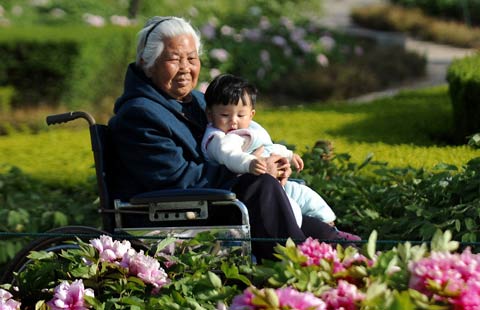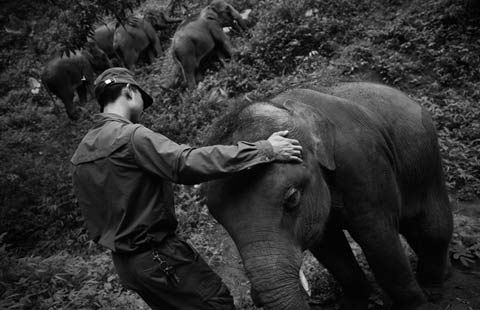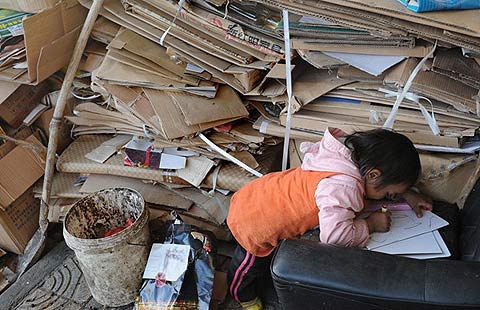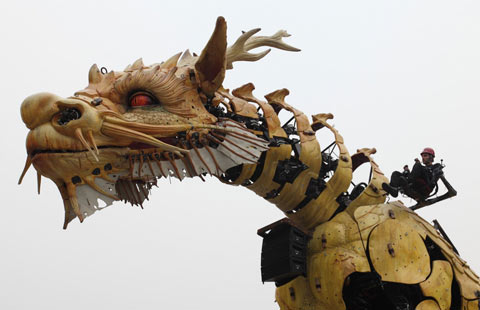Jade is his trade
Updated: 2014-10-28 07:27
By Deng Zhangyu(China Daily)
|
|||||||||||
Wang Junyi is sharing his artwork to show that the greenstone is more than just a mark of nobility. Deng Zhangyu reports.
The history of jade sculpture in China dates back several thousand years, and it has always been seen as an exquisite craftsmanship serving royal families and the wealthy. But Wang Junyi wants to show that the greenstone can also serve the public.
On Oct 21, Wang unveiled his plan in Beijing for a yearlong world tour of his works. Starting next month, his solo show of jade sculptures will begin visits to more than 10 cities including Paris and Venice. The Louvre will be the first stop.
Instead of carving from a single piece of jade, Wang incorporates different types of metals into his works, such as gold, silver and titanium alloy.
The Nile, one of 31 works that will be on display at the Louvre, resembles the museum with its pyramid-shape. The tiny jade sculpture was made in 2007.
Transforming into Butterfly is an installation of a lifelike butterfly, held together by metal threads. "Jade is a special medium for me to create works, just as other artists use marble, bronze or porcelain," says Wang, 40.
Wu Weishan, director of the National Art Museum of China, says Wang's work is a combination of traditional craftsmanship, modern design and installation.
Wang's jade works focus on three subjects: Buddha, animals and flowers. The artist said his international show will feature more animals and flowers so "foreign audiences can easily understand" his pieces.
Jade has long enjoyed popularity in Asia. But in Europe, few understand the culture. Wang is confident that his jade installations will be accepted in other countries, as art is a universal language.
Wang began sculpting jade at the age of 19, and says that the art requires extreme patience. It usually takes months or years for Wang to finish one piece, and he spends up to eight hours a day carving jade.
"There's an old Chinese phrase that says, 'One can't tell whether it's the man who carves the jade or it's the jade that carves the man,'" he says.
Wang has created nearly 100 works over the past 20 years, including dozens of "big pieces" like Ice Butterflies, a highlight of his well-known show at the National Museum of China in 2012. It took him five years to make 13 jade pieces resembling butterflies and melting ice. The jade pieces represent the Earth's deteriorating environment.
Wang says he plans to make another 200 jade butterflies to represent all of the countries in the world.
In 2005, Christie's held Wang's first auction in Hong Kong. After that sale, Wang became a frequently traded name at Chinese auction houses such as Poly and Hanhai.
Wang says he wants to blur the line between jade art and jade sculpture. For hundreds of years, the stone has been a mark of royal families and feudal nobility. Jade sculpture has long been measured according to its purity and level of transparency.
Wang emphasizes the artistic design of the greenstone. "If people visiting my studio only want to discuss how good the material is, I will immediately ask them to leave," he says.
"I hope more people join me in emphasizing the artistic design when making a jade work. It's a better way to enlarge jade's influence in the future," adds Wang.
Wang says he's worried about the shortage of artists dedicated to jade sculpture. He plans to set up an art foundation to cooperate with art colleges and support students who pursue a career in jade sculpture.
Contact the writer at dengzhangyu@chinadaily.com.cn
(China Daily 10/28/2014 page22)
Today's Top News
Poroshenko's bloc leads parliamentary election
Occupy Central 'hatched 2 years ago'
Ukraine's early parliamentary election kicks off
Envoy champions UK China relations
Highlights of Shenzhen Int’l Photography Week
Palace Museum needs to design landmark souvenirs
In Guangdong, 42 hours of fear
Ambassador urges young people to build up ties
Hot Topics
Lunar probe , China growth forecasts, Emission rules get tougher, China seen through 'colored lens', International board,
Editor's Picks

|

|

|

|

|

|





